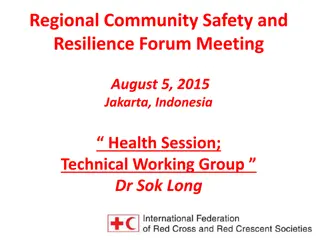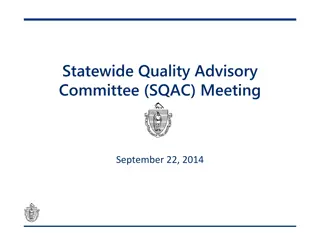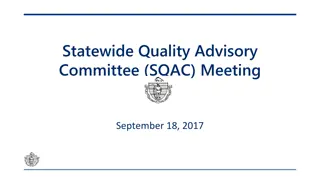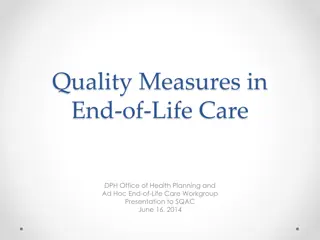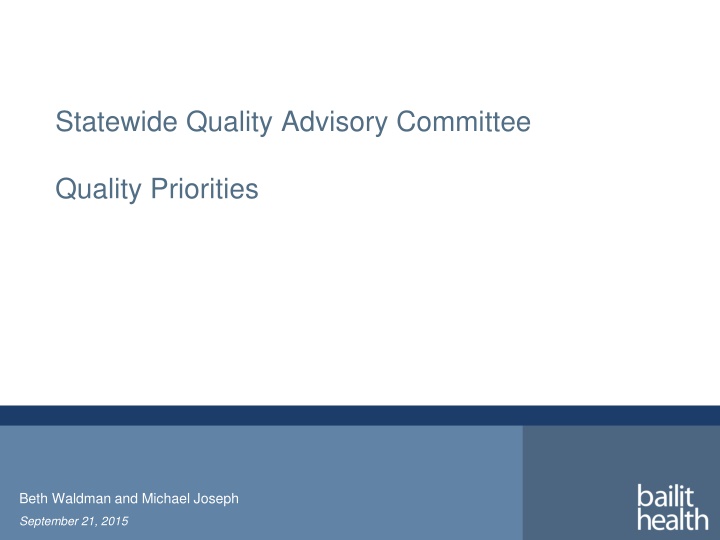
Statewide Quality Advisory Committee Prioritizes Quality Initiatives
The Statewide Quality Advisory Committee, led by Beth Waldman and Michael Joseph, focuses on evaluating quality measures, finalizing quality priorities, and addressing key healthcare issues such as facility-based care appropriateness and end-of-life care. The committee emphasizes collaborative efforts for improving healthcare quality across various settings.
Download Presentation

Please find below an Image/Link to download the presentation.
The content on the website is provided AS IS for your information and personal use only. It may not be sold, licensed, or shared on other websites without obtaining consent from the author. If you encounter any issues during the download, it is possible that the publisher has removed the file from their server.
You are allowed to download the files provided on this website for personal or commercial use, subject to the condition that they are used lawfully. All files are the property of their respective owners.
The content on the website is provided AS IS for your information and personal use only. It may not be sold, licensed, or shared on other websites without obtaining consent from the author.
E N D
Presentation Transcript
Statewide Quality Advisory Committee Quality Priorities Beth Waldman and Michael Joseph September 21, 2015
Agenda Welcome and Business Items 3:00 3:05 MHA-MAHP Proposed Tiering Measures 3:05 3:35 Measure Evaluations 3:35 3:45 Finalization of Quality Priority Selections 3:45 4:45 Other/Next Steps 4:45 5:00 SQAC September 21, 2015 2
Measure Evaluations Measures reviewed using SQMS evaluation criteria Suitability for tiering not assessed Performance variance Room for improvement Relevance for all payers Results All measures met threshold for strong recommendation Considerations Readmissions amenability to improvement (condition- specific v. system-wide) NQF endorsement retraction CMS will make some measures voluntary (FY16 Final Rule); or retire them SQAC September 21, 2015 3
Finalization of QUALITY PRIORITY SELECTIONS SQAC September 21, 2015 4
Appropriateness of Facility-Based Care (1 of 2) Description: A significant percent of health care spend is considered wasteful; in recent years there has been a concerted effort to reduce unnecessary use of facilities, particularly in the areas of readmissions and preventable hospitalizations, whether from the community or skilled nursing facilities. Why highlight: Continued opportunity for improvement Requires coordinated and collaborative community effort Avoidable admissions and readmissions are expensive, disruptive and disorienting Particularly true for frail elders and persons with disabilities SQAC September 21, 2015 5
Appropriateness of Facility-Based Care (2 of 2) How to improve quality: Improved discharge planning and follow-up care Involvement of the PCP Improved patient activation and self-care management Improved care coordination Other key factors: Significant quality measurement underway by CHIA and others Potential to close gaps in disparities Significant state work underway; will boost current efforts SQAC September 21, 2015 6
End of Life Care (1 of 2) Description: Emerging focus on support and medical care given to patients during the time surrounding death. Includes decisions about medical treatments, hospitalizations, admissions to skilled nursing facilities, palliative care and hospice as well as patient and family decision making. Why highlight: Significant variation in the amount and cost of intervention near the end of a patient s life. Interventions often do little if anything to improve a patient s chance for sustained improvement. Increased focus on end of life care can improve quality and patient experience. SQAC September 21, 2015 7
End of Life Care (2 of 2) How to improve quality: Increased counseling and shared decision-making Honest conversation about chance for improvement and harm of treatment Other key factors: Existing quality measures in SQMS SQAC September 21, 2015 8
Maternity Care (1 of 2) Description: Care provided to an individual while pregnant, during delivery and at follow-up post-birth Why highlight? High cost service area that impacts almost everyone Opportunities for improvement Area where patients are more willing to proactively choose provider SQAC September 21, 2015 9
Maternity Care (2 of 2) How to improve quality: Reduction of C-section rates Increased rate of women having a vaginal birth after cesarean (VBAC) Reduced provider variation, through increased use of best practices. Other key factors: Significant quality measurement CHIA already working in this area SQAC September 21, 2015 10
Opioid Use (1 of 2) Description: Opioid epidemic in Commonwealth and across country Increased rates of use, overdoses and overdose deaths Why highlight? Reinforce work of Administration and others to combat epidemic. Significant work to identify and implement ways to improve access to substance use treatment services, including provision of additional funding to support prevention, intervention, treatment and recovery. Support implementation efforts by measuring progress. SQAC September 21, 2015 11
Opioid Use (2 of 2) How to improve quality: Improve access to and pricing of Naloxone (Narcan) Improve compliance with the Prescription Monitoring Program (PMP) Improve understanding of access to the behavioral health system Improve access to treatment services through mandates on commercial insurers to cover services without prior authorization Improve access to medication assisted treatment (MAT) Improve access to services covered through the Department of Public Health s Bureau of Substance Abuse Services (BSAS), including residential recovery homes and recovery support centers Other key factors: Measurement of success is difficult; relapse is an expected and common part of the recovery process SQAC September 21, 2015 12
Integration of Behavioral Health and Primary Care (1 of 2) Description: Integration of behavioral health with primary care allows for an individual to receive integrated care of all conditions within a primary care practice that is supported by behavioral health clinicians. Why highlight? Improved integration is a key focus of delivery system reform, particularly for Medicaid. Focus on whole person, not conditions based on how health care system is organized. SQAC September 21, 2015 13
Integration of Behavioral Health and Primary Care (2 of 2) How to improve quality: Improved access to behavioral health services May lead to earlier detection and/or intervention of behavioral health issues Treating behavioral health issues concurrently with medical issues, such as diabetes, may also lead to improvements in those conditions Other key factors: Quality measurement for integration is in progress Focus on whole person may help reduce disparities; improve patient activation and ease care coordination Significant statewide activity to promote integration SQAC September 21, 2015 14
Questions for Group Discussion Priority Selection Are you comfortable with these topic areas? Should they all be included as priorities? Can we narrow any of them? How can the SQAC prioritize these topics over the three year period? How frequently should the SQAC review these priorities? What can SQAC do to advance these quality priority topics? SQAC September 21, 2015 15
Next Steps Monday, October 19: Wrap up of Quality Priorities Selection and Discussion of Implementation Plan SQAC September 21, 2015 16





